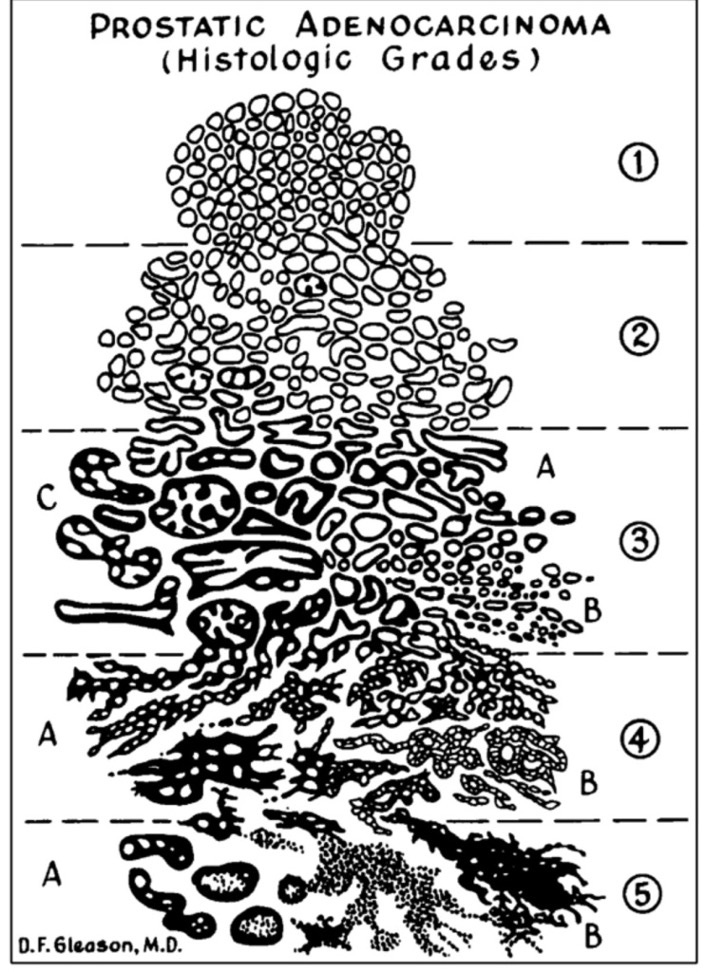Dr. Donald Gleason, the former chief of pathology at the Minneapolis Veterans Administration Center, devised a prostate cancer grading system many years ago that is still used today. His legacy, the system that he devised and that bears his name, provides one of the best guidelines for predicting the prognosis and guiding the treatment of an individual case of prostate cancer. The goal of this entry is to provide a clear understanding of this important grading system that has been a source of confusion for many patients.
Dr. Donald Gleason
GLEASON GRADE
Gleason grade is determined by the examining pathologist who studies the biopsied prostate tissue under a microscope. Grade is a measure of how abnormal the prostate cancer cells look microscopically, indicative of the extent of difference in the cellular architecture of cancer cells as compared with normal cells. Low-grade cancers appear almost like normal cells whereas high-grade cancers bear little resemblance to normal cells. Dr. Gleason determined that prostate cancer grade was the most reliable indicator of the potential for cancer growth and spread.
Historically, Gleason grades ranged from 1 to 5. Grades 1 and 2 are no longer utilized because these low pathology grades were poorly reproducible even among expert pathologists and correlated poorly with the final grade as determined by prostatectomy (surgical removal of the prostate). Currently, the lowest grade assigned to a cancer is 3 and the highest is 5. Gleason grade 3 is just over the threshold for cancer, whereas Gleason grade 5 refers to cells that have the most cancerous appearance.
Gleason grade 3 = low-grade (least aggressive)
Gleason grade 4 = intermediate-grade
Gleason grade 5 = high-grade (most aggressive
The original Gleason grading system: grades 1-5
GLEASON SCORE
The cancer from any individual biopsy site is often heterogeneous as opposed to homogeneous. In other words, cancer cells can show various architectural patterns, often a predominant pattern as well as secondary and tertiary patterns. To determine Gleason score, the pathologist assigns a separate numerical grade to the two most predominant architectural patterns of the cancer cells, the first number representing the grade of the primary (most predominant) pattern and the second number representing the grade of the secondary pattern. The sum of the two grades is the Gleason score. The lowest possible score is 6; the highest is 10.
Gleason score predicts the aggressiveness and behavior of the cancer. Higher scores indicate a worse prognosis than lower scores because the more mutated cells typically grow faster than the more normal-appearing ones. Prognosis also depends on further refinements. For example, a Gleason score of 7 can occur two ways: “4+3” or “3+4”. With “4+3,” cancer cells in the most predominant category appear more aggressive than those in the secondary pattern, suggesting a more serious threat than a “3+4” score, in which cells in the most predominant group appear less aggressive.
Gleason score ranges
Gleason score 3+3 = 6 (lowest score)
Gleason score 3+4 = 7 or 4+3 = 7
Gleason score 4+4 = 8 or 3+5 = 8 or 5+3 = 8
Gleason score 4+5 = 9 or 5+4 = 9
Gleason score 5+5 = 10 (highest score)
GLEASON GRADE GROUPS
The Gleason score system in which the lowest grade prostate cancer is a 6 and the highest grade is a 10 is a major source of confusion to many patients. Because of the complexity of communicating information concerning prostate cancer aggressiveness, prognosis, and clinical management to patients using a grading system ranging from 6 to 10, a new system has been developed called the Gleason grade group, using a simple scale of 1 to 5. The new system classifies Gleason score 6 as Grade Group 1, which makes it easier for a patient to understand their clinical situation and is now the preferred means of communication.
The 5 Gleason grade groups based upon Gleason score are as follows:
Grade Group 1: Gleason score 3+3 = 6
Grade Group 2: Gleason score 3+4 = 7
Grade Group 3: Gleason score 4+3 = 7
Grade Group 4: Gleason score 4+4 = 8 or 3+5 = 8 or 5+3 = 8
Grade Group 5: Gleason score 4+5 = 9 or 5+4 = 9 or 5+5 = 10
Distribution of Gleason Grade Groups Among Newly Diagnosed Patients
A study of almost 1000 patients with newly diagnosed prostate cancer determined the following distribution of Gleason Grade Groups:
Grade Group Newly Diagnosed Patients
Grade Group 1 31%
Grade Group 2 31%
Grade Group 3 21%
Grade Group 4 6%
Grade Group 5 11%
Wishing you the best of health and a great weekend,
Andrew Siegel, MD






Extremely helpful! Thank you!